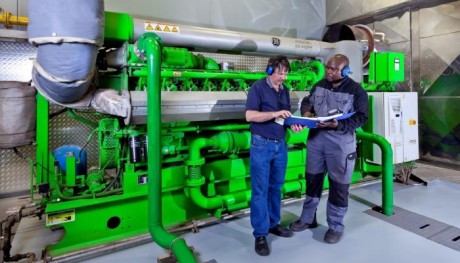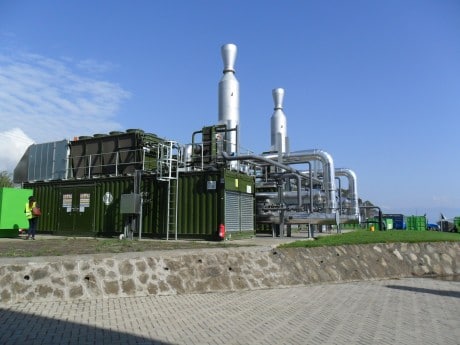 Many countries in the developed world created power generation networks based upon large centralised power generation stations with significant investment in power transmission and distribution networks. From the African context this has not happened yet there is a huge need to increase power generation capacity. The thought of addressing this through a small number of large gas, hydro, coal or nuclear-fuelled power stations seems attractive at first, however the goals of supplying power for all in Africa, could be better addressed with de-centralised distributed generation, lots of smaller localised power stations to address the electrification needs quickly.
Many countries in the developed world created power generation networks based upon large centralised power generation stations with significant investment in power transmission and distribution networks. From the African context this has not happened yet there is a huge need to increase power generation capacity. The thought of addressing this through a small number of large gas, hydro, coal or nuclear-fuelled power stations seems attractive at first, however the goals of supplying power for all in Africa, could be better addressed with de-centralised distributed generation, lots of smaller localised power stations to address the electrification needs quickly.
A challenge with large centralised power stations is how to maximise the energy content of the valuable fuels. Coal power stations may convert the energy in the fuel to only 40% electricity. With the most modern efficiency gas-turbine power plants this may be increased to 60%. All of the remaining energy is lost through heat. In addition, further power losses occur through transmission lines, where moving electricity from point of generation to user, can be as much as 2%. Then there is the issue of electricity theft along the line, which is a controversial issue as well as a dangerous practice. The investment in this transmission infrastructure is also significant as well as time consuming and poses its own challenges.
 The developed world is now moving away from these centralised power systems towards a more decentralised option. Decentralised energy produces power close to the site of use, reducing losses associated with transmission and improves energy efficiency. If it incorporates a combined heat and power plant total fuel efficiency may be as high as 90-95% by using both the electricity and waste heat created during the production of power and utilisation of the original fuel. The heat can be used to generate steam, hot water or can be used directly in a drier or industrial facility. It can also be converted to cooling, though an absorption chiller – a valuable driver for air conditioning or refrigeration systems – particularly relevant in the African context. Industrial plants in Nigeria are moving towards the deployment of CHP and trigeneration technology. Diageo’s Guinness Ogba brewery was one of the African pioneers.
The developed world is now moving away from these centralised power systems towards a more decentralised option. Decentralised energy produces power close to the site of use, reducing losses associated with transmission and improves energy efficiency. If it incorporates a combined heat and power plant total fuel efficiency may be as high as 90-95% by using both the electricity and waste heat created during the production of power and utilisation of the original fuel. The heat can be used to generate steam, hot water or can be used directly in a drier or industrial facility. It can also be converted to cooling, though an absorption chiller – a valuable driver for air conditioning or refrigeration systems – particularly relevant in the African context. Industrial plants in Nigeria are moving towards the deployment of CHP and trigeneration technology. Diageo’s Guinness Ogba brewery was one of the African pioneers.
Micro-grids development in Africa is an interesting concept, particularly if it is deploying renewable energy technology in the form of wind or solar power. However both wind and solar are intermittent power generation technologies. Storage of electricity is costly. One solution to this would be to supplement with micro-grid with a gas fuelled engine operating on biogas. Biogas is a renewable fuel generated from the degradation of organic waste or energy crops. Gas can be stored and used to generate electricity when is needed. Whilst European biogas plants often generate at full capacity for close to 100% of the year, in order to generate the maximum level of feed in tariff payments, in Africa, a different model could be deployed with a greater amount of gas storage and redundancy in the engines, so power can be generated when is most needed in order to balance the grid. Tropical Power’s new waste fuelled biogas plant in Kenya, is developed for this particular approach, combing biogas with combined heat and power and solar technology.
If there is no opportunity for the deployment of biogas in a given area, an alternative would be to use natural gas or diesel. Both of these are costly fuels and are not renewable sources of energy. Therefore if these are used, then a key requirement for the asset is the maximisation of fuel efficiency. GE’s new ‘616’ diesel generator is a 2.5MW engine, that requires only 184g/kWh of fuel, meaning significant fuel savings and reduced carbon emissions versus established technology. This is currently being deployed for the first time globally at a major flour mill in Nigeria.
At the recent East Africa Power Industry Convention in Nairobi a “round table” discussion was held to investigate how to develop Africa’s power generation network and whether to opt for a centralised or decentralised system. The general consensus was a hybrid solution was the optimal one. With some larger plants being deployed in major urban areas such as Nairobi or Dar es Salaam which have a significant demand for power. Consistent users of electricity and heat would benefit from CHP technology and offsetting energy demand with solar power during the day. A distributed power generation would mean a more balanced and stable transmission network and reduced investment costs. Creating energy from waste materials was also deemed an attractive proposition and there is significant un-tapped potential for the generation of power from organic waste, sewage and water treatment plant as well as dump-sites.
In summary the development of sub-Saharan Africa’s power generation infrastructure is largely a blank sheet of paper. The continent should be able to learn from its more developed neighbours and jump a step in its electrical infrastructure development and move towards a more fuel efficient, lower carbon and sustainable system. Maximisation of valuable energy resources will play a key part in the world’s future development.




